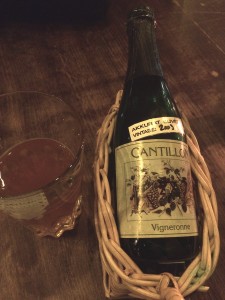In Stockholm we visited what is arguably the #1 beer bar in the world – Akkurat. There we drank this aged gem; Cantillon Vigneronne from 2003. This is a fruited lambic that was rested on muscat grapes:
 Cantillon Vigneronne, 2003
Cantillon Vigneronne, 2003
Usually when I tell someone I drank a 12 year old beer, their first question is: “Why would you ever want to do that?”
TL;DR: because it is delicious.
If you’d like to know more, allow me to drop some beer science. You probably already know that beer gets its alcohol via fermentation. Yeast and bacteria (henceforth “bugs”) eat sugars you have extracted from grains. They poop out alcohol, plus some other organic compounds that give some beers their unique flavors. So next time you crack a cold one, think “mmm, bug poop.”
The reason you age anything is to allow flavors to mature. For living products (think cheese), you’re giving bugs more time to work their magic. For sterile products (say, Scotch), you’re waiting for slow moving chemical reactions to work their magic.
Most domestic beers do not benefit from either of these processes. The most noticeable flavor component in many beers is hops. Hops contribute both bitterness, and floral or fruity notes to beers. When it comes to hops, chemical reactions are your enemy. The organic molecules that give you those great flavors are volatile. They quickly break down with time and heat. Ideally, you want to drink any of your hoppy beers within 2 weeks, and you really don’t want them to ever get hot.
From the “living products” side, large brewers flash pasteurize. This means they heat the brew up really high for a short period of time. This kills all the bugs in it. Putting any age on your standard beer is going to result in degraded hops, and no biological activity. So don’t go sticking your High Life in the beer cellar.
Now there are other brewers in the world that make beers that are meant to be aged. Perhaps the oldest in this business are Belgian lambic brewers/gueuze blenders. They use minimal hops, and they don’t flash pasteurize. They also use a process called “spontaneous fermentation.” In a normal brew you carefully control the addition of yeast to the batch. In spontaneous fermentation you leave your beer open to the world overnight, and wild yeast from the air move in and start eating sugars and pooping out alcohol and flavor. Before the advent of modern sanitization, pretty much everything was spontaneously fermented.
One important note about these wild bugs (and some of their cultivated descendants) is that they are slower moving. They will keep eating and pooping in your bottle for a long, long time. The master lambic brewers are actually amazing at running grand microbiology experiments. Their beers contain an advanced and shifting ecology of bugs, and when it’s all working right, the results are stupendous.
This means a bottle from a brewery like Cantillon will change and evolve for literally decades, and it will be improving for much of that time. Sadly, unlike with wine, there aren’t many people cellaring old gueuze/lambic. It is a rare treat to get to try something that has been aged for more than a few years, which is why I was so excited to visit Akkurat and try something from their vintage list.